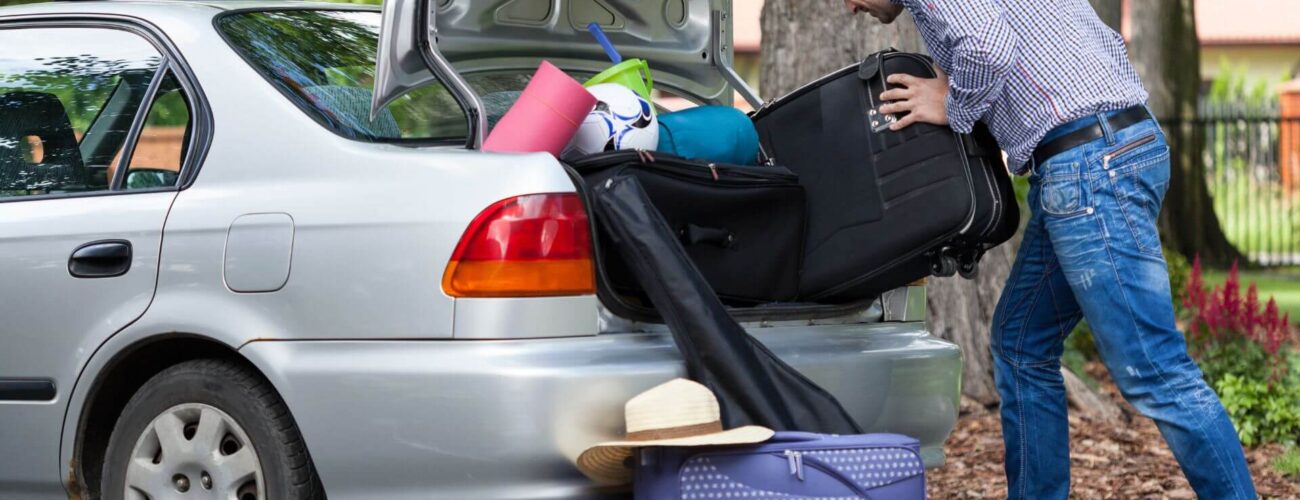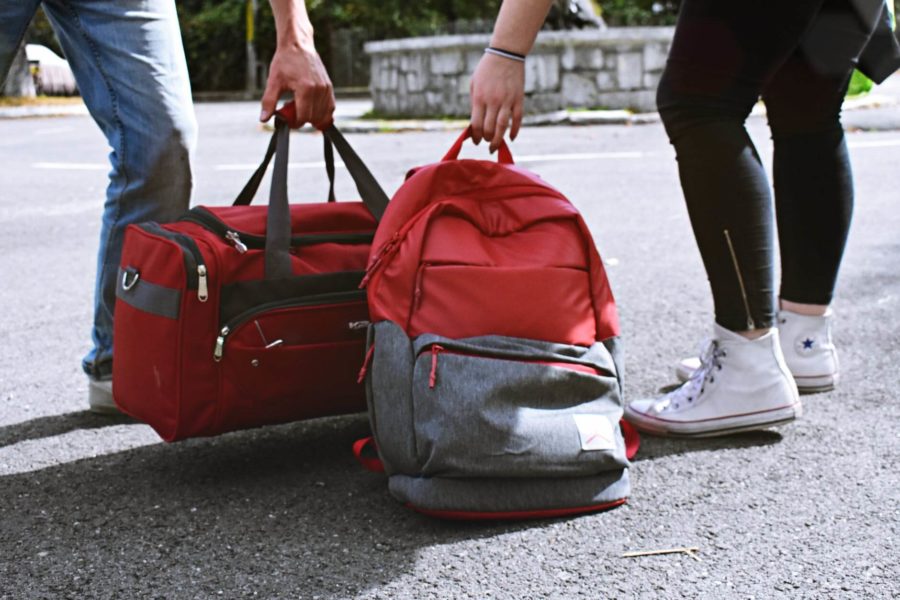

How to Pack a Car for Moving – A Guide to Efficient Usage of Space
Posted in How-to,Moving Tips & Tricks on May 30, 2022
Driving is one of the best ways to get from point A to point B, but it can be challenging across long distances. Some people think relocating by car is easy, but, truthfully, that depends on many factors. Here’s how to pack a car for moving efficiently, safely, and without too much hassle.
You might think you know how to best pack a car for moving across the country, but there’s much to consider. You’ll need essential equipment and creative materials for packing and not allow the cargo to obstruct your view. If it becomes too much, use our ultimate relocation guide and simply prepare for movers instead.
How to Best Pack a Car for Moving to Another State and Use the Space to Its Full Potential
It’s normal to wonder what is the most efficient way to pack a car when you’re relocating to a new city alone or want to significantly reduce relocation costs. Driving alone can be comfortable but exhausting since no one can replace you when you get tired. Many stops and delays can make your trip longer.
Hiring cross-country moving services can be more affordable than driving yourself because many factors determine the cost of your trip. In more ways than one, you’ll move faster with professional help, but you’re not here for that. You’re here because you want to learn how to prepare your vehicle for a road trip, and that’s what we’ll discuss.
Declutter Your Home Before Any Type of Packing Happens
Planning your relocation should start early – months before, to be exact. Being prepared is crucial for such a significant endeavor, and we recommend that you organize all your documents and reminders into a relocation binder.
Stuff wears out over time, becomes dated, or just breaks. Keeping all of it won’t do you any favors, so you must downsize for a move. Coincidentally, downsizing is also crucial for packaging your belongings in the vehicle you plan to move with. It’s not possible to drive your whole place across the country, so prioritizing is the first thing to do.
If you’re unsure where to begin with downsizing, the woman in the video below explains the process and how to declutter with the principle of the four Ps. It’s also an ideal solution for last-minute relocation.
How to Pack a Small Car for Moving Cross Country? The Secret Is Not Packing Boxes and Bulky Items
If you wish to move with just a car, you’ll have to leave a lot behind and avoid packaging fragile items. Long story short, you can’t bring much. However, you can maximize the space and safety in your vehicle by taking a few shortcuts. You’ll learn how to pack a small car for moving cross country and what’s really necessary.
The benefit of relocating in a small four-wheeler is having less to unpack after moving cross country. If you don’t like to spend precious minutes unwrapping plates and would rather use that time to get to know your new home, this scenario is ideal.
Using boxes is always tidier, but they are bulky and hard to navigate in small spaces. Of course, you can find a corner for small containers with some essentials, but it’d be better to plan your driver’s getaway by bringing less or using more small containers.
Instead of Packing Too Many Boxes, Pack With Plastic Bags Instead
How many boxes can fit in a car? Not too many. So, how do you move with just a car? By replacing one solution with others that fit the circumstances. You will indeed package clothes, but not all of your outfits will fit in the suitcase.
Everything you don’t frequently wear or is out of season can be packed into bags – plastic or any other. Prioritize your wardrobe by dividing it into piles – have a suitcase of essential clothes for the first couple of weeks; anything out of season can go into plastic bags (if you can vacuum seal them, that’d be ideal.) It won’t be like the packaging services movers provide, but it’ll do the trick.
Most importantly, the clothes you don’t wear or want anymore have to go – it can be thrown away, donated, or sold. Just remove it from your possession and say goodbye forever. Goodbyes are tough, but they can lead to better things in life. Someone smart must have said that once.
Avoid Buying New Stuff Just Before Relocation
Even more important than prioritizing, decluttering, and downsizing is foresight. If you plan to move to a new city with just your car, shopping for new stuff beforehand will be silly. Not only is it a terrible way to save money to move, but it’ll make relocation last much longer.
It’s a simple solution – pause your shopping sprees until after the move and splurge on fresh fits and household items with the money you have left after relocating. If you’ve downsized and planned well enough, that sum will be good enough to go shopping with for a bit.

What Should Be Packed First When Moving Across the Country With My Own Transport?
The chances of you packing into boxes are high, so consider that when planning how to lay everything out in the car. Ideally, relocating alone will give you the most liberty, as you can lay the car seats flat and load the vehicle quickly.
If you’ve ever read tips on loading a relocation truck, you might remember that the first things to load should be bulky, heavy items. They go to the front of the truck so that any sudden braking or turn doesn’t cause them to press and break the smaller, more fragile things.
In your four-wheeler, the order should be the same. It’s best to place the heavier, bulkier boxes or bags first. You can leave the passenger’s seat lifted and lean the containers onto it; this way, sudden movement won’t disrupt the layout. Protect yourself by securing the containers with rope.
How to Pack a Car for Moving to Another State as Best as Possible?
In relocating alone, using the back seats and trunk area will come in handy, but things can go even better if you lower the seats and pile your belongings onto them.
You will need equipment like security belts, rope, or bungee cords to secure the more fragile or valuable packages to the seats. If you can install an overhead carrier or rack on the roof, this will solve more problems than imaginable.
An overhead carrier can fit a lot, but for some things, you might need to roll down the windows and strap them to the roof. That’s where rope and bungee cords will come in handy. The trick is to create room and take advantage of every nook and cranny, just don’t overfill the car with unnecessary, inconvenient, or unsafe items.
How Do I Fit Everything in My Car When I Also Have Pets and/or Children?
You could be relocating with pets, a friend, a sibling, a partner, or with children. With most seats filled out and reserved for people to sit on, there’s less room for bags of valuable and essential items.
How do you park a car into a household inventory list and make everything come together? An overhead carrier will be one of the ideal solutions. Also, use the space under the seats – place whatever can fit down there. Your pets should stay in their carriers during the trip; of course, let them out whenever you take a break and leash them while you’re outside.
If there’s free space under the backseats, like a spare compartment, use that for the containers with more fragile items. Finally, the ultimate solution would be to rent a trailer and just load the essentials there.

Here’s When to Consider Relocating By Car and When to Call Cross-Country Movers
Sometimes it’d be best to go the easier route and hire professionals to do the packing and transportation. You can use professional cross-country moving services without sacrificing your entire budget. Movers typically bring their packing materials for relocating and offer benefits like storage services and mandatory relocation insurance.
Pros can also give you some relocation tips since there are items movers won’t move and wouldn’t recommend that you transport them, either. Here’s when to consider relocating with professional movers:
- Your cargo is too large – if you’re relocating to an empty home and want to bring as much furniture as you can, relocating by car only will be very complicated and, to be honest, impossible,
- The distance between your old and new home is too large – going from coast to coast by car is an act of insanity, especially with cargo jumping up and down in the back of your vehicle,
- The car is not in the best condition of its life – if you have pending repairs or it recently started getting the hiccups when you start it up, why take the risk of driving?
- You don’t have the time to figure out a packing and loading layout – if you’re relocating at the last minute and don’t have enough days on your calendar to plan a DIY vehicle-only move, it’s better to leave those chances to professionals.
What You Get When You Choose Auto Transport Services
For anyone wondering what professional relocation companies can do with car transport services, we’ll answer some common questions to dispel the anxiety. They can help you choose the right way to relocate your car, and more importantly, how to do it safely.
Can I Move With My Car and Still Call Movers?
Yes, you can. Cross-country movers can package some of your belongings and leave the rest to you. This way, you can put the essentials into your four-wheeler and drive the distance while knowing that the rest of your stuff will arrive safely at its destination.
Combining these two relocation methods will give you a sense of control and provide the professional safety and security you may not be able to achieve on your own.
Can Long-Distance Movers Transport My Car, Too?
If you didn’t know, many relocation companies also offer auto shipping services. Using them with the essential relocation package will help you move safely and worry-free. You can then forget about driving and fly to your new home.
In this scenario, the options for reaching your destination increase; just don’t forget to bring the essentials with you, such as clothes, bed linens, towels, and everything necessary to go through the first couple of weeks at a freshly settled location.
Will My Stuff Be Safe With Long-Distance Movers?
Many people avoid hiring cross-country movers because they have high anxiety about long-distance moving. That’s understandable since we never know when a company is what it presents itself to be. Luckily, it’s become easy to check if a relocation company is legitimate.
Professional and legit long-distance movers must register their company and vehicles at the FMCSA and have a USDOT number. You can employ this research tactic, along with a few others, to verify the legitimacy of your cross-country movers.
It’s Alright to Move By Car, But Cross Country Movers Can Be Way More Helpful When It Comes to Relocating
For anyone relocating for the first time, packaging and driving independently might be the toughest thing they’ve ever done. Preparing your four-wheeler for relocation can last a while, as cars must be constantly maintained, and gas prices have recently gone up.
All these expenses amount to a hefty sum lost on something that could have been dealt with by professionals. That’s why you can contact Cross Country Movers and let us take care of everything for you – from cross-country moving to auto shipping and storage, you name it.
Still, we wouldn’t blame you if you wanted to try this adventure on your own and have everything set out already. In that case, the sky is the limit, and your road trip can begin with you knowing that things will go smoothly because you made sure of it.
Frequently Asked Questions About How to Pack a Car for Moving
What Is the Best Way to Pack a Car for Moving?
The best way to pack a car for moving cross-country is to maximize space by using boxes and containers of various sizes, organizing items by weight and fragility, and securing everything in place with straps, bungee cords, or tie-downs. Additionally, leave enough space for the driver and passengers to sit comfortably and to ensure that all items are securely fastened to prevent shifting during transit.
How Can I Make the Most Efficient Use of Space When Packing a Car for Moving?
When packing a car for a move, maximizing space is key. You can do this by stacking them vertically, and filling gaps with soft items like clothing or towels. Be mindful of the weight and fragility of your items and organize them accordingly.
Heavier items should be placed low and close to the center of the vehicle, while fragile items should be protected and secured in place. Use straps to prevent items from shifting during transit. Remember not to exceed the weight capacity of the vehicle.
What Items Should I Prioritize Packing In My Car When Moving?
When moving, prioritize packing essential items that you will need immediately upon arrival, such as toiletries, medications, important documents, and a change of clothes. You may also want to pack valuable or sentimental items that cannot be easily replaced. Additionally, consider packing items that are too fragile or valuable to be transported in a cross-country moving truck, or items that you prefer to have with you for security reasons, such as electronic devices or jewelry.
How Can I Protect My Belongings While Packing Them in My Car for Moving?
To protect your belongings when packing them, wrap them in bubble wrap or packing paper. Fill any gaps to prevent stuff from shifting during transit. Secure everything in place and minimize movement by using straps. Avoid overloading your vehicle, and be sure to park in a safe and secure location during rest stops or overnight stays.
What Are the Best Packing Materials for a Car Move?
The best packing materials for a car move are sturdy boxes or containers of various sizes, packing paper or bubble wrap for fragile items, soft items like clothing or towels to fill gaps, and straps, bungee cords, or tie-downs to secure everything in place. Additionally, it’s helpful to have a dolly or hand truck to move heavier items and furniture pads or blankets to protect larger items from scratches or dents.
How Can I Prevent Items From Shifting and Getting Damaged During Transport?
To prevent items from shifting and getting damaged during transport, wrap them with bubble wrap within the boxes, fill gaps with packing peanuts or paper, use straps to secure everything, and distribute weight evenly throughout. Place heavier items low and closer to the center of the vehicle, and avoid overloading the vehicle. You should also drive carefully, taking turns and bumps slowly to minimize movement.
Should I Pack Items by Category or by Room When Moving in a Car?
When moving in a car, it’s best to pack items by category rather than by room. This means grouping similar items together, such as kitchenware or clothing, instead of packing everything from one room at once. This allows for more efficient use of space and helps to prevent damage to fragile items that may be packed with heavier objects in a room-based approach.
How Can I Pack Fragile or Valuable Items for Safe Transport in a Car?
To pack fragile or valuable items for safe transport in a car, wrap them individually in bubble wrap or packing paper and place them in sturdy boxes. Fill the gaps to prevent stuff from shifting during transit. Label the boxes as “fragile” and avoid stacking heavy items on top of them. For added protection, you may consider packing these items in your personal vehicle rather than a moving truck.
What Should I Do With Large Items or Furniture When Packing a Car for Moving?
When packing a car for moving, large items or furniture can be packed securely with furniture pads or blankets to prevent scratches or dents. If possible, disassemble large items and pack the pieces in boxes or wrap them with moving blankets. Use a dolly or hand truck to move heavy items and secure them in place with straps. If necessary, consider renting a trailer or using professional cross-country moving services to transport large items.
What Should I Do With Pets When Packing a Car for Moving?
When packing a car for long-distance moving, pets should be properly secured and kept safe. Consider keeping pets in a separate vehicle or arranging for them to travel with a friend or family member. If pets must travel in the same vehicle, secure them in a carrier or crate and place it in a well-ventilated and temperature-controlled area.
Pack plenty of food, water, and any necessary medications or supplies for your pets, and take frequent breaks to allow them to stretch and relieve themselves. Additionally, make sure that any accommodations you plan to stay at during your trip are pet-friendly.
How Can I Pack Food and Other Perishable Items for Transport in a Car?
When packing food and other perishable items for transport in a car, use insulated coolers with ice packs or dry ice to keep them fresh. Pack perishables together and keep them separate from non-perishables. Label the cooler and avoid opening it frequently to maintain the temperature. Plan your route accordingly and try to limit the time that perishables are in the car to avoid spoilage. If traveling for an extended period, consider purchasing non-perishable food items at your destination.
How Can I Pack Electronic Devices and Appliances for Safe Transport in a Car?
To pack electronic devices and appliances for safe transport in a car, wrap them safely and use sturdy boxes. Label the boxes as “fragile” and avoid stacking heavy items on top of them.
Secure the boxes in place to prevent shifting during transit. If possible, pack electronics and appliances in their original packaging to provide extra protection.
Keep smaller items such as cords and cables organized in labeled bags or containers. Avoid exposing electronics and appliances to extreme temperatures or moisture.
How Can I Make the Loading and Unloading Process Easier When Packing a Car for Moving?
To make the loading and unloading process easier when packing a car for moving, organize items by weight and fragility, and pack them strategically for easy access. Place heavier items closer to the center of the vehicle, and fragile items in a protected position.
Label boxes as “fragile” or “heavy” to help with organization. Use furniture pads or blankets to protect large items from scratches or dents. Consider enlisting the help of friends or family members to make the loading and unloading process smoother and more efficient.
Are There Any Weight Limits or Restrictions When Packing a Car for Moving?
There are weight limits and restrictions when packing a car for moving across the country. Check the owner’s manual or contact the manufacturer to determine the weight capacity of your vehicle.
Overloading your car can lead to safety hazards, such as poor handling or tire failure. Exceeding weight restrictions may result in fines or other penalties. It is best to distribute weight evenly throughout the vehicle and avoid overloading it beyond its capacity.
How Can I Ensure a Smooth and Safe Journey When Packing a Car for Moving?
To ensure a smooth and safe journey, plan ahead and prepare carefully. Make sure everything is securely packed and fastened to prevent shifting during transit. Avoid overloading the vehicle and distribute weight evenly throughout the car. Drive carefully and take frequent breaks to rest and stretch. Make sure to stay hydrated and well-rested, and finally, obey traffic laws and follow safe driving practices to reach your destination safely.




